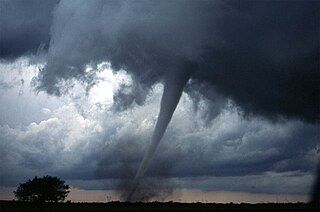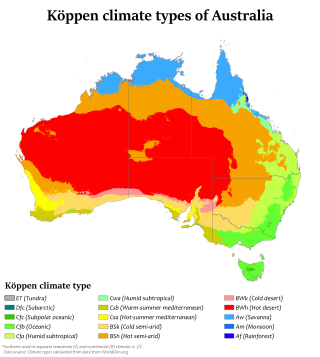Related Research Articles

Jet streams are fast flowing, narrow, meandering air currents in the atmospheres of some planets, including Earth. On Earth, the main jet streams are located near the altitude of the tropopause and are westerly winds. Jet streams may start, stop, split into two or more parts, combine into one stream, or flow in various directions including opposite to the direction of the remainder of the jet.

Extreme weather or extreme climate events includes unexpected, unusual, severe, or unseasonal weather; weather at the extremes of the historical distribution—the range that has been seen in the past. Often, extreme events are based on a location's recorded weather history and defined as lying in the most unusual ten percent. The main types of extreme weather include heat waves, cold waves and tropical cyclones. The effects of extreme weather events are seen in rising economic costs, loss of human lives, droughts, floods, landslides and changes in ecosystems.

A heat wave, or heatwave, or extreme heat, is a period of excessively hot weather, which may be accompanied by high humidity, especially in oceanic climate countries. While definitions vary, a heat wave is usually measured relative to the usual climate in the area and relative to normal temperatures for the season. Temperatures that people from a hotter climate consider normal can be called a heat wave in a cooler area if they are outside the normal climate pattern for that area.

The effects of climate change impact the physical environment, ecosystems and human societies. The environmental effects of climate change are broad and far-reaching. They affect the water cycle, oceans, sea and land ice (glaciers), sea level, as well as weather and climate extreme events. The changes in climate are not uniform across the Earth. In particular, most land areas have warmed faster than most ocean areas, and the Arctic is warming faster than most other regions. The magnitude of impacts of climate change can be reduced by climate change mitigation and adaptation.

Australia's climate is governed mostly by its size and by the hot, sinking air of the subtropical high pressure belt. This moves north-west and north-east with the seasons. The climate is variable, with frequent droughts lasting several seasons, thought to be caused in part by the El Niño-Southern Oscillation. Australia has a wide variety of climates due to its large geographical size. The largest part of Australia is desert or semi-arid. Only the south-east and south-west corners have a temperate climate and moderately fertile soil. The northern part of the country has a tropical climate, varying between grasslands and desert. Australia holds many heat-related records: the continent has the hottest extended region year-round, the areas with the hottest summer climate, and the highest sunshine duration.

Severe weather is any dangerous meteorological phenomenon with the potential to cause damage, serious social disruption, or loss of human life. Types of severe weather phenomena vary, depending on the latitude, altitude, topography, and atmospheric conditions. High winds, hail, excessive precipitation, and wildfires are forms and effects of severe weather, as are thunderstorms, downbursts, tornadoes, waterspouts, tropical cyclones, and extratropical cyclones. Regional and seasonal severe weather phenomena include blizzards (snowstorms), ice storms, and duststorms. Extreme weather phenomena that cause extreme heat, cold, wetness or drought often will bring severe weather events. One of the principal effects of anthropogenic climate change is changes in severe and extreme weather patterns.

Climate change in Australia has been a critical issue since the beginning of the 21st century. Australia is becoming hotter and more prone to extreme heat, bushfires, droughts, floods, and longer fire seasons because of climate change. Climate issues include wildfires, heatwaves, cyclones, rising sea-levels, and erosion.
The climate of Uttar Pradesh (U.P.) is primarily defined as humid subtropical with dry winter (Cwa) type with parts of Western U.P. as hot semi-arid (BSh) type. Alternatively, some authors refer to it as tropical monsoon. Variations do exist in different parts of the large state, however the uniformity of the vast Indo-Gangetic Plain forming bulk of the state gives a predominantly single climatic pattern to the state with minor regional variations. U.P. has a climate of extremes. With temperatures fluctuating anywhere from 0 °C or 32 °F to 50 °C or 122

Climate change in Pakistan is a major issue for the country. Pakistan is highly vulnerable to climate change. As with the changing climate in South Asia as a whole, the climate of Pakistan has changed over the past several decades, with significant impacts on the environment and people. In addition to increased heat, drought and extreme weather in parts of the country, the melting of glaciers in the Himalayas has impacted some of the important rivers of Pakistan. Between 1999 and 2018, Pakistan ranked 5th in the countries affected by extreme weather caused by climate change.
The 2016 Indian heat wave was a major heat wave in April and May of that year. A national record high temperature of 51.0 °C (123.8 °F) was set in the town of Phalodi, in the state of Rajasthan. Over 160 people died with 330 million affected to some degree. There were also water shortages with drought worsening the impact of the heat wave.

Climate change in Alabama encompasses the effects of climate change, attributed to man-made increases in atmospheric carbon dioxide, in the U.S. state of Alabama.

The 2018 European drought and heat wave was a period of unusually hot weather that led to record-breaking temperatures and wildfires in many parts of Europe during the spring and summer of 2018. It is part of a larger heat wave affecting the northern hemisphere, caused in part by the jet stream being weaker than usual, allowing hot high-pressure air to linger in the same place. According to the European Drought Observatory, most of the areas affected by drought are across northern and central Europe. According to the World Meteorological Organization, the severe heat waves across the northern hemisphere in the summer of 2018, are linked to climate change in Europe, as well as events of extreme precipitation.

Friederike (Fredi) Elly Luise Otto is a climatologist who as of December 2021 works as a Senior Lecturer at the Grantham Institute for Climate Change and the Environment at Imperial College London. Previously she was Associate Director of the Environmental Change Institute (ECI) at the University of Oxford. Her research focuses on answering the question whether and to what extent extreme weather conditions change as a result of external climate drivers. A highly recognized expert in the field of attribution research, she examines the extent to which human-caused climate change as well as vulnerability and exposure are responsible for events such heat waves, droughts and floods. Together with climate scientist Geert Jan van Oldenborgh she founded the international project World Weather Attribution which she still leads. In 2021, she was included in the Time 100, Time's annual list of the 100 most influential people in the world. She was also one of ten scientists who had had important roles in scientific developments in 2021 highlighted in the scientific journal Nature.
Extreme event attribution, also known as attribution science, is a relatively new field of study in meteorology and climate science that tries to measure how ongoing climate change directly affects recent extreme weather events. Attribution science aims to determine which such recent events can be explained by or linked to a warming atmosphere and are not simply due to natural variations.

This page documents notable heat waves worldwide in 2021.
Geert Jan van Oldenborgh was a Dutch climatologist and physicist. Through his career he studied climate modelling of adverse weather events and was known as a pioneer of attribution science, driving public awareness of how climate change is linked to extreme weather events. He was also the creator of a digital platform, Climate Explorer, an online meteorological data repository and platform for climate data analysis.

The 2022 heat wave in India and Pakistan is an extreme weather event which has resulted in the hottest March in the subcontinent since 1901. The hot season arrived unusually early in the year and extended into April, affecting a large part of India's northwest and Pakistan. The heatwave has combined with a drought, with rainfall being only a quarter to a third of normal. The heat wave is remarkable for occurring during a La Niña event.
From June to 31 August 2022, China had a severe heat wave which affected several provinces and municipalities. To date, it is the country's worst heat wave to have existed. According to weather historian Maximiliano Herrera, it is the most severe heat wave recorded anywhere in the world.
References
- 1 2 Roston, Eric; Gu, Jackie (July 19, 2022). "Is the Heat Wave Caused By Climate Change? This Is What Scientists Say". Bloomberg News. Retrieved 2022-11-17.
- ↑ Hayhoe, Katherine; Otto, Friederike (August 17, 2021). "What Cutting-Edge Science Can Tell Us About Extreme Weather". New York Times. Retrieved 2022-11-17.
- ↑ "The climate project that changed how we understand extreme weather". Radio France Internationale . AFP. October 22, 2021. Retrieved 2022-11-25.
- ↑ Fountain, Henry (October 22, 2021). "Geert Jan van Oldenborgh, 59, Dies; Linked Weather Disasters to Climate Change". New York Times . Retrieved 2022-11-17.
- ↑ "About World Weather Attribution initiative". World Weather Attribution. Retrieved 2022-11-17.
- ↑ van Oldenborgh, G.J.; van der Wiel, K.; Kew, S.; et al. (2021). "Pathways and pitfalls in extreme event attribution". Climatic Change. Springer. 166 (13): 13. Bibcode:2021ClCh..166...13V. doi:10.1007/s10584-021-03071-7. S2CID 234099522 . Retrieved 2022-11-17.
- ↑ Noack, Rick (April 26, 2021). "French vineyards devastated by April frost that followed unusually warm March". Washington Post. Retrieved 2022-11-25.
- ↑ "Climate change increased the likelihood of damaging frosts from the French April 2021 cold wave by about 60%" (Press release). Government of France, Commissariat à l’énergie atomique et aux énergies alternatives. June 18, 2021. Retrieved 2022-11-25.
- ↑ Kabukuru, Wanjohi (November 16, 2022). "Nigeria floods 80 times more likely with climate change". AP NEWS . Retrieved 2022-11-25.
- ↑ "Climate change exacerbated heavy rainfall leading to large scale flooding in highly vulnerable communities in West Africa" (Press release). World Weather Attribution. November 16, 2022. Retrieved 2022-11-25.
- ↑ Butler, Lottie; Stack-Maddox, Siobhan (May 26, 2022). "Climate change made deadly heatwave in India and Pakistan 30 times more likely" (Press release). Imperial College London. Retrieved 2022-11-25.
- ↑ Ghosal, Aniruddha (May 24, 2022). "South Asia's intense heat wave a 'sign of things to come'". AP NEWS . Retrieved 2022-11-25.
- ↑ Zhong, Raymond (December 1, 2021). "'So Many Dimensions': A Drought Study Underlines the Complexity of Climate". The New York Times. ISSN 0362-4331 . Retrieved 2023-01-10.
- ↑ "Factors other than climate change are the main drivers of recent food insecurity in Southern Madagascar" (Press release). World Weather Attribution. December 1, 2021. Retrieved 2023-01-10.